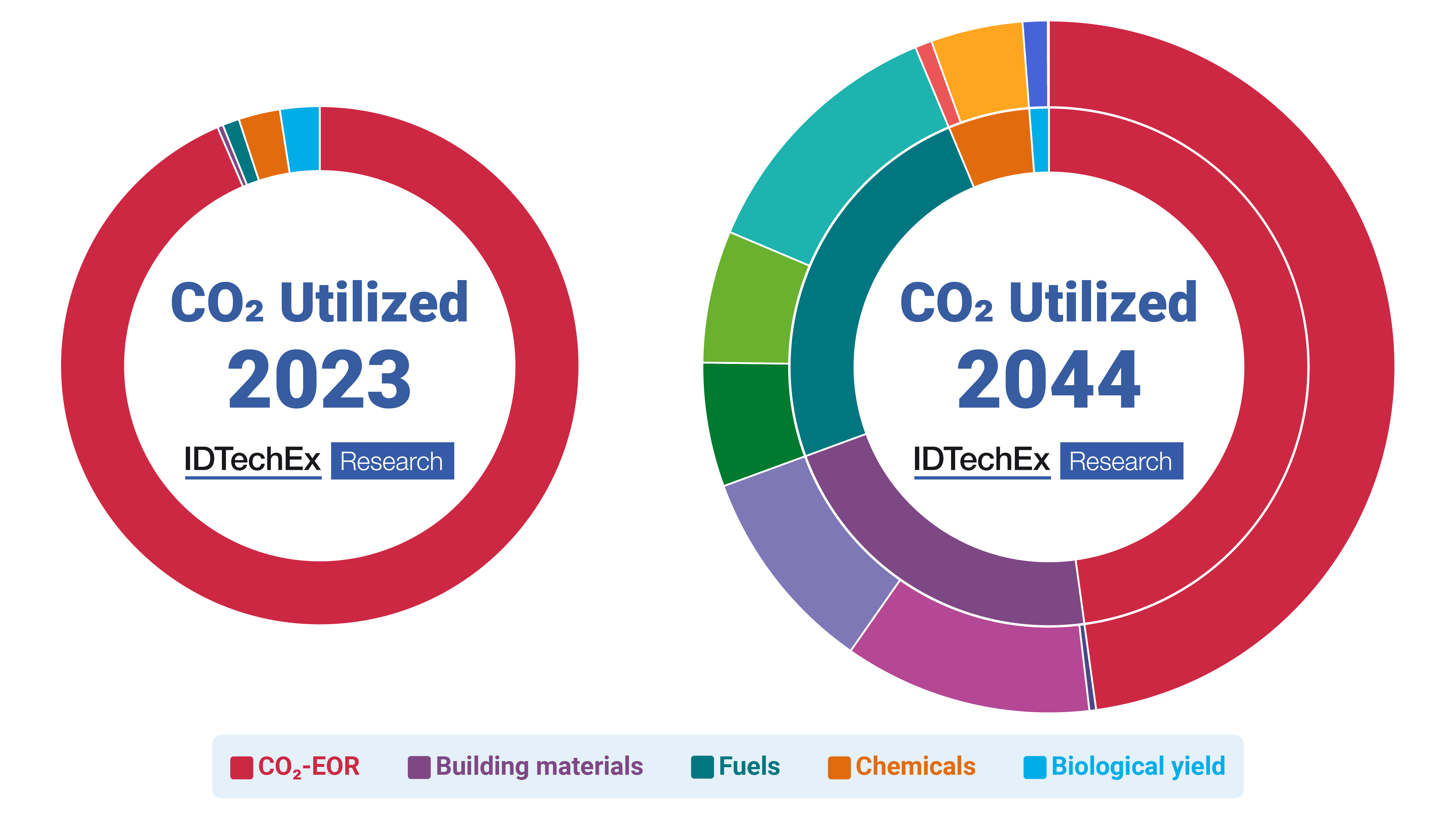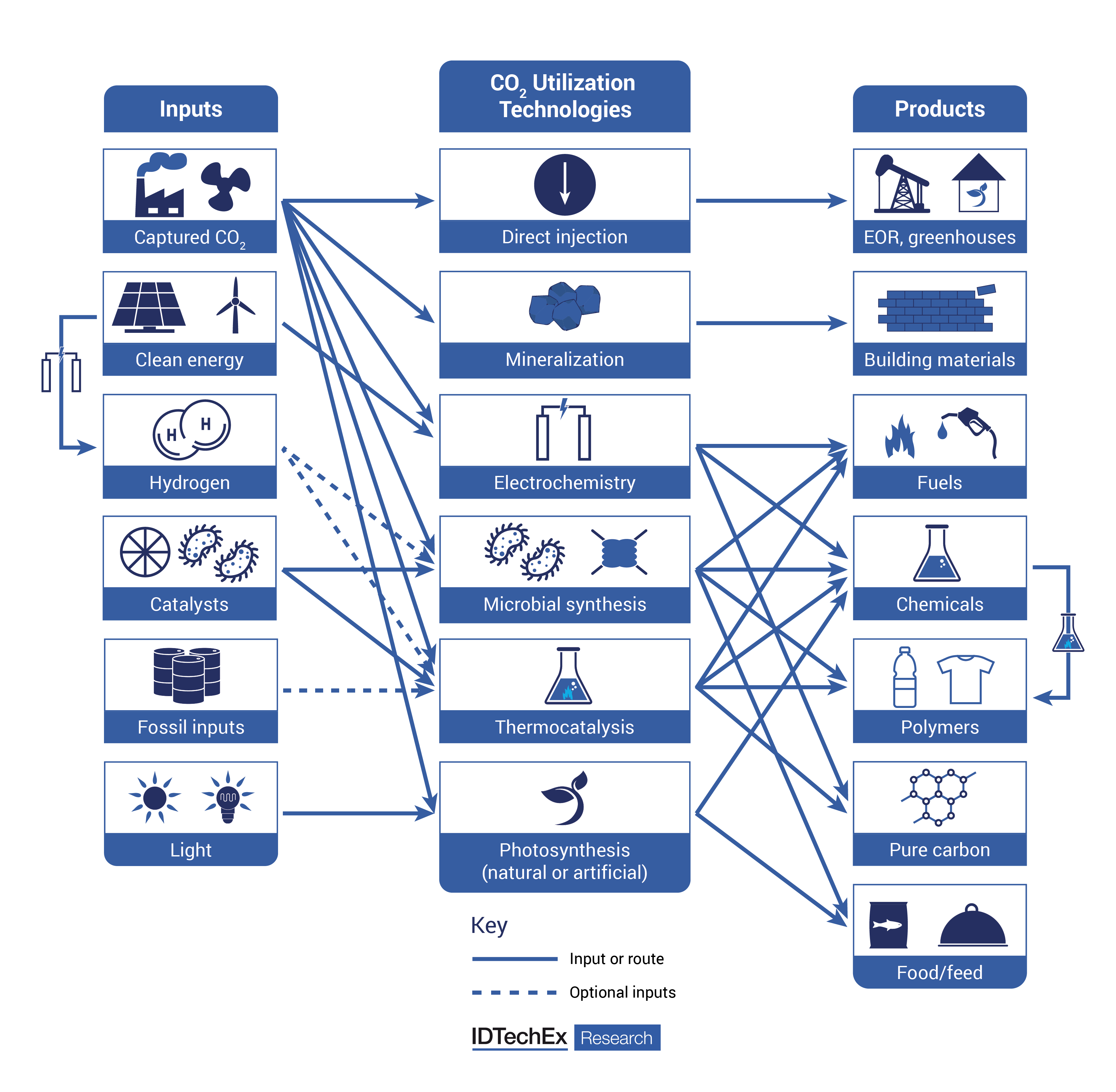
|
Author: Eve Pope, Technology Analyst at IDTechEx IDTechEx predicts that by 2044, utilization of waste CO2 will reach 800 Mt to create over 3,000 Mt of useful products. Revenue generated through carbon dioxide utilization (CO2U) over the next two decades will be vital to enabling the development of commercially viable CO2 capture technologies for the future. In combination, carbon capture, utilization, and storage (CCUS) technologies are critical in supporting the decarbonization of the world’s economy as countries strive to reach net zero goals. The new report published by IDTechEx, “Carbon Dioxide Utilization 2024-2044: Technologies, Market Forecasts, and Players”, provides a comprehensive outlook of the global CO2 utilization industry, with an in-depth analysis of the technological, economic, and environmental aspects that are set to shape this emerging market over the next twenty years. The report also includes a twenty-year granular forecast for the deployment of 11 CO2U product categories, covering the amount of CO2 utilized and the revenue generated, alongside 30+ interview-based company profiles. IDTechEx considers CO2 use cases in enhanced oil recovery, building materials, liquid and gaseous fuels, polymers, chemicals, and in biological yield-boosting (crop greenhouses, algae, and fermentation), exploring the technology innovations and opportunities within each area.
|
||

|
IDTechEx predicts significant growth of several CO2U applications over the next twenty years. Source: IDTechEx |
||
|
What is CO2 utilization? Carbon dioxide utilization technologies refer to the practical use of waste CO2, captured abiotically using direct air capture or point source capture of industrial emitters (including industrial biogenic carbon dioxide sources), to create financial benefits and produce net CO2 emissions reduction or removal. Manufacturing pathways include direct injection, mineralization, electrochemistry, microbial synthesis, thermocatalysis, and photosynthesis. Alongside promoting a more circular economy, CO2U can also sometimes result in products with enhanced properties. Carbon dioxide utilization products provide climate benefits by displacing fossil-fuel-based incumbents; some are net-zero or even net-negative.
|
||

|
Emerging applications of CO2 utilization: inputs, manufacturing pathways, and products made from CO2. Source: IDTechEx |
||
|
Despite its potential to create a market for waste CO2, not all CO2U technologies are created equal. These systems face a range of economic, technical, and regulatory challenges that need to be carefully considered so that the technologies that actually provide climate benefits – and are economically viable – can be prioritized and pursued. For instance, for many CO2U routes, the CO2 sequestration is only temporary, with the CO2 utilized being released to the atmosphere once the product is consumed (e.g., CO2-derived fuels or proteins), while for others, the CO2 can be stored permanently (e.g., CO2-derived building materials). On the economic side, many CO2U pathways can be considerably more expensive than their fossil-based counterparts due to high energy requirements, low yields, or the need for other expensive feedstock (e.g., green hydrogen, catalysts). This IDTechEx report, “Carbon Dioxide Utilization 2024-2044: Technologies, Market Forecasts, and Players”, provides insights into the most promising processes being developed in CO2U, highlighting the pros and cons of each pathway and end-product. Innovative companies worldwide are developing technologies to improve the energy efficiency of CO2 conversion processes and reduce their costs. This report gives an overview of these players' latest developments, with first-hand accounts of the challenges and opportunities within the industry. Market outlook for carbon dioxide utilization CO2-derived building materials and CO2-derived fuels represent the areas with high growth potential. Both markets intrinsically have large CO2 utilization potentials, but each have its own specific drivers. CO2U in building materials is the more straightforward CO2U technology, able to lower the carbon footprint of ready-mixed concrete, pre-cast concrete, and carbonate aggregates/supplementary cementitious materials through mineralization reactions. Carbon dioxide can be permanently stored, and cement use can be reduced. Growth will be driven by new certifications, superior materials performance, and the ability to achieve price parity through waste disposal fees. CO2-derived fuels market penetration is expected to come largely from regulations already being put in place, such as fuel-blend mandates for long-haul transportation. As green hydrogen electrolyzer capacity scales up worldwide, production of e-fuels from carbon dioxide using power-to-x technology (including e-methanol, synthetic natural gas, e-diesel, e-kerosene, and e-gasoline production) will also increase. Several CO2-derived fuels are already being commercially produced (with many more commercial facilities expected over the next decade) and could play a role in decarbonizing shipping and aviation (as full electrification of the aviation and maritime sectors is currently unfeasible and is likely to remain so for the foreseeable future). Some CO2-derived chemicals (particularly CO2-derived polycarbonates) are already produced commercially but only require relatively small amounts of CO2 compared to other applications. While potentially all carbon containing chemicals could utilize carbon dioxide in production, those requiring non-reductive pathways are the most promising due to a smaller energy demand. Carbon dioxide utilization in crop greenhouse enrichment is another mature application set to grow once CO2 pipeline transport infrastructure expands. Several companies look to circumvent this transportation problem by using DAC (direct air capture) on-site. CO2-EOR will remain the biggest application area over the next two decades due to its profitability, established infrastructure, and continued demand for oil. IDTechEx finds that after a slow but steady progress during this decade, the CO2U market will likely grow rapidly from the 2030s onwards to reach 800 Mt by 2044. Revenue generated by CO2U is currently dominated by CO2-EOR, but building materials, fuels, and chemicals will gain a significant share over the next twenty years. Key questions answered in this report:
To find out more about the new IDTechEx report “Carbon Dioxide Utilization 2024-2044: Technologies, Market Forecasts, and Players”, including downloadable sample pages, please visit www.IDTechEx.com/CO2U. For more information on IDTechEx’s energy and decarbonization market research portfolio, please visit www.IDTechEx.com/Research/Energy. Upcoming free-to-attend webinar The Role of CO2 Utilization in Achieving Carbon Neutrality Eve Pope, Technology Analyst at IDTechEx and author of this article, will be presenting a free to attend webinar on Wednesday 7 February 2024 – The Role of CO2 Utilization in Achieving Carbon Neutrality. This webinar will reveal insights into CO2U technologies, and its content includes:
Click here to find out more and register your place on one of our three sessions. If you are unable to make the date, please register anyway to receive the links to the on-demand recording (available for a limited time) and webinar slides as soon as they are available. |

